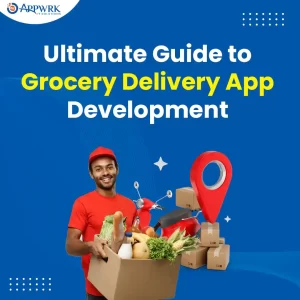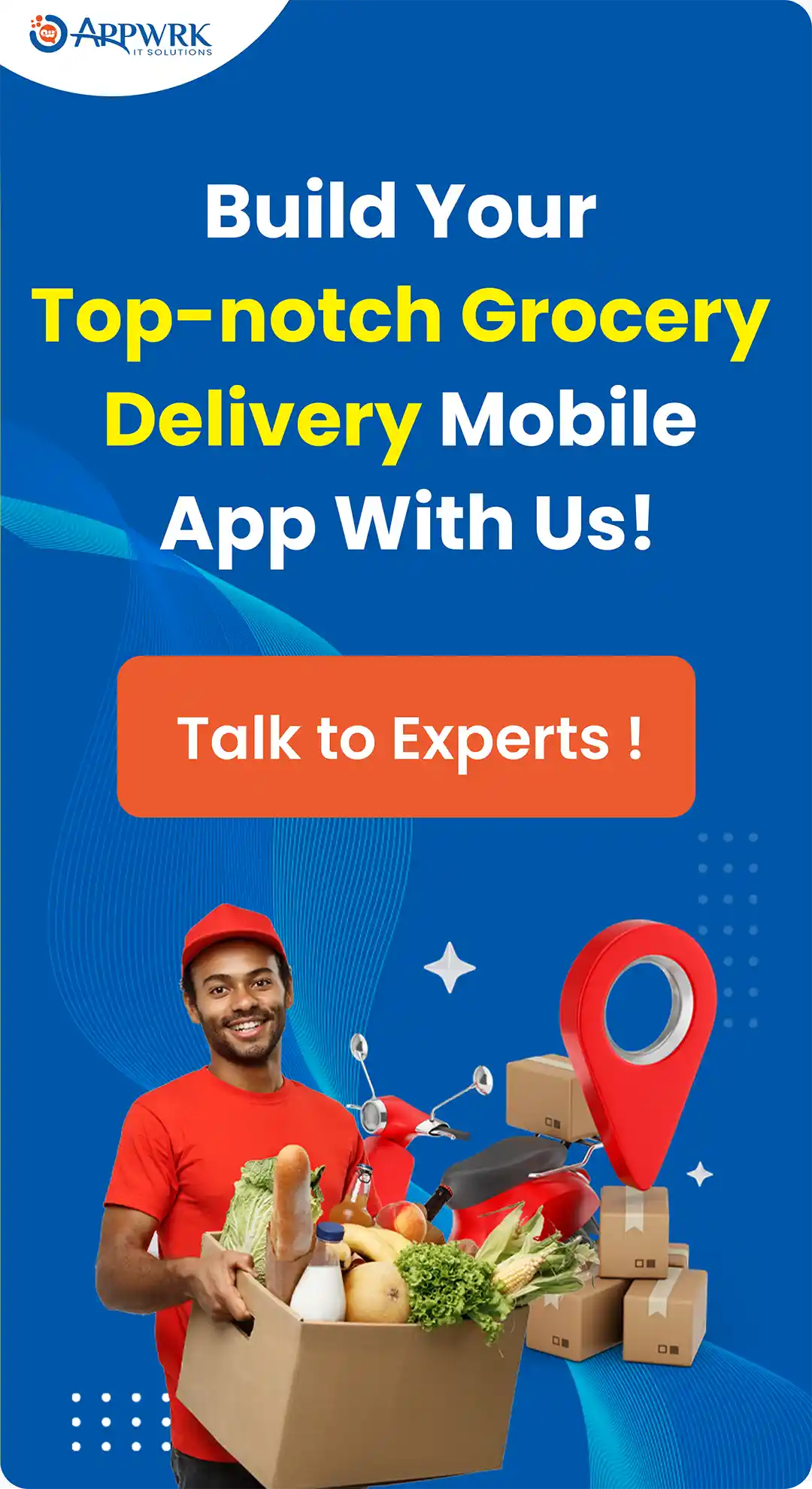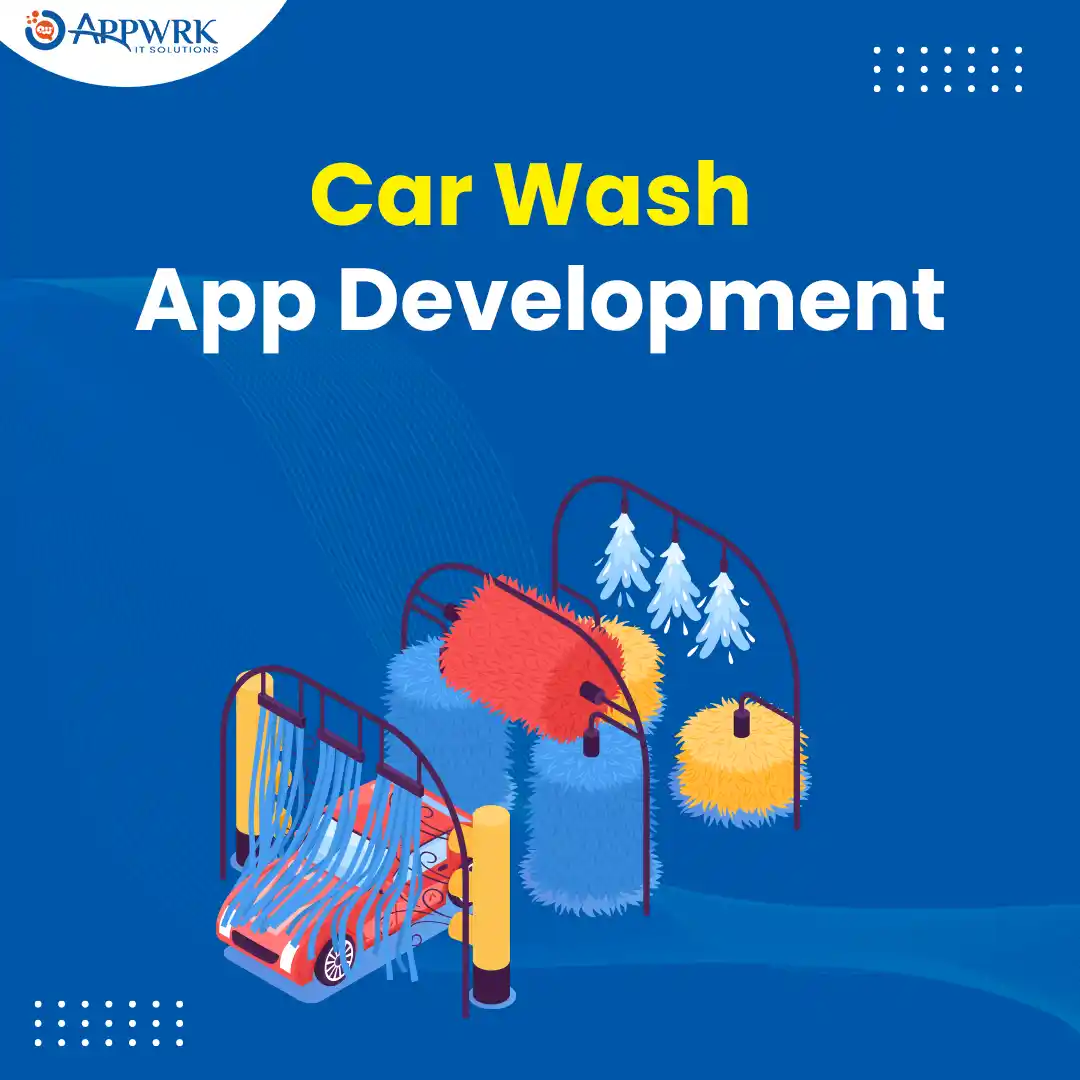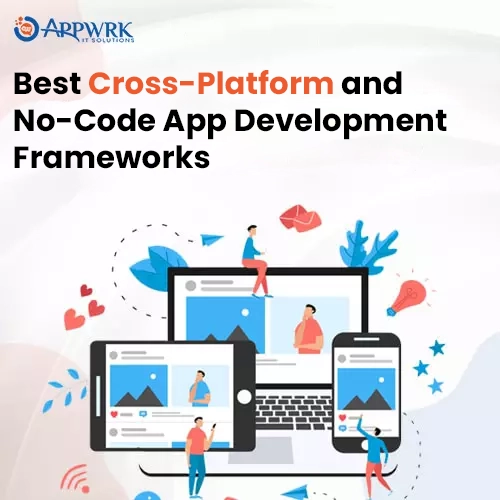Ultimate Guide to Grocery Delivery App Development: Shaping the Future of Online Grocery Shopping
Grocery delivery applications have undoubtedly revolutionized the whole food industry in recent years. All these on-demand delivery apps have made life so much easier that people have found their comfort in just a few taps! Today, customers can order anything they want to eat in just one tap, and yes it will be delivered to their doorstep in a minimal time period.
Increased demand for this effortless and quick online service among customers has led to an increase in the development of grocery apps and has motivated entrepreneurs and grocery store owners to accept this new way of doing business.
In this era of hectic life schedules, these grocery delivery apps have become a blessing for most people, due to which the grocery app market is exceedingly growing every day! Thus, knowing the hype for grocery app development in the market is crucial. Let us provide you with some insights.
Table of Contents
- Grocery Delivery Application Market Trends: Insights for Successful Grocery App Development
- Defining a Grocery Delivery Mobile App
- Advantages of Grocery Delivery Mobile App Development
- Optimized Inventory and Order Management
- Unparalleled Customer Convenience
- Leveraging Consumer Behavior Data for Personalized Offers
- Boosting Customer Loyalty with Customized Loyalty Programs
- Minimizing Overhead and Enhancing Efficiency
- Real-Time Order Tracking for Transparency
- Multiple Payment Options for User Flexibility
- Exploring Various Grocery Delivery App Models: Choosing the Right Approach for Development
- Top Grocery Delivery Apps Dominating the Market in 2023: Learning from the Best in the Industry
- Essential Features for an Engaging Grocery App: User, Vendor, and Admin Panels
- Selecting the Right Technology Stack for Your Grocery Store App Development
- Designing a Robust Architecture for Your Grocery Delivery App
- Choosing the Ideal Revenue Model for Your Online Grocery Delivery App
- Step-by-Step Guide to Developing a Successful Grocery Delivery Application
- Step 1- Comprehensive Market Research and Planning
- Step 2- Select the Right Development Partner
- Step 3 – Determine the Optimal Platform
- Step 4- Design and Develop a Minimal Viable Product
- Step 5- Test, Refine, and Launch Your Application
- Step 6- Marketing Your Grocery App
- Step 7 – Continuous Analysis and Improvement
- Assembling the Perfect Team to Build a Grocery Delivery Mobile App
- Reasons to Invest in Grocery Delivery Mobile App Development
- Understanding the Cost Factors in Developing a Grocery Delivery App
- Challenges of Making a Grocery Shopping App (With Their Solutions)
- APPWRK IT Solutions – Grocery Delivery App Development Company
- Conclusion
- FAQs and Expert Answers
Grocery Delivery Application Market Trends: Insights for Successful Grocery App Development
According to the data provided by Statista:
- The global grocery delivery market revenue is estimated to reach US $565.30 billion in 2023.
- It is expected to expand at a compound annual growth rate (CAGR) of 15.41%, resulting in a projected market volume of US $1,003.00 billion by 2027.
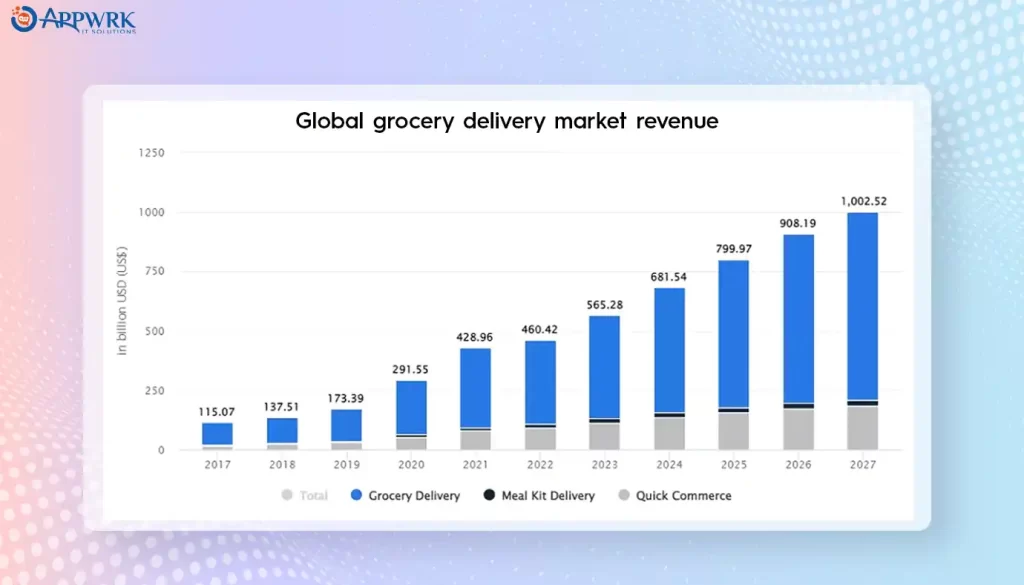
Other data from Statista shows:
- The online grocery customer base in the US might reach 163 million, close to half of the population by 2025, and is projected to grow more in the upcoming years.

From the above data, you must have got a clear picture that the online grocery market has been gaining traction post-lockdown due to social distancing standards, busy lifestyles, changing consumer shopping habits, and tech-savvy youth who prefer purchasing everything online.
Defining a Grocery Delivery Mobile App
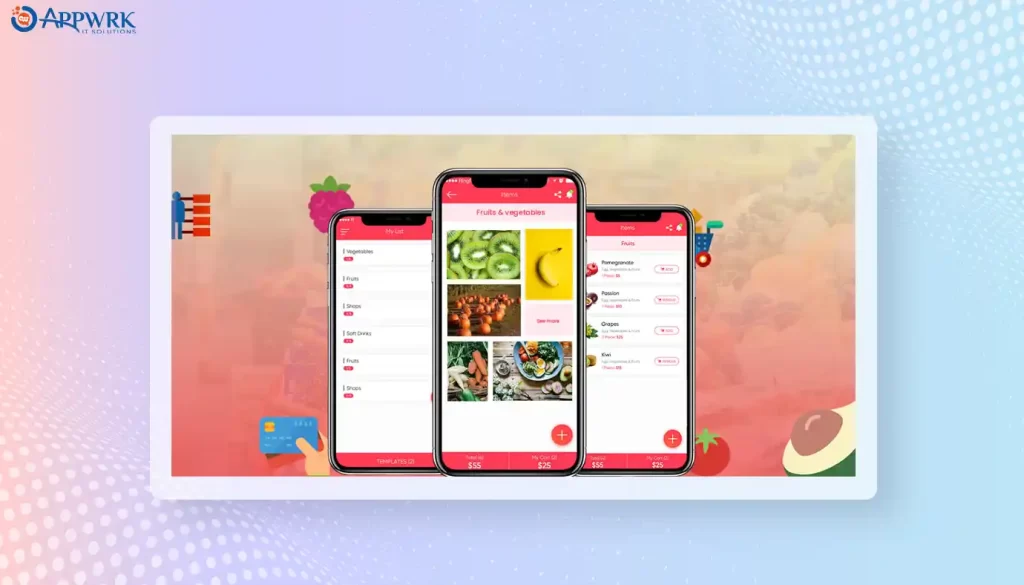
Just one click away from ordering fresh groceries and providing you with doorstep service! Grocery delivery mobile apps have made lives more convenient by providing every food-related item, such as milk, meat, fresh fruits and vegetables, and household items. The shoppers just have to log in to the app, share a list of groceries required, put it in the shopping cart, and it gets delivered with hassle-free payments through multiple payment gateways provided in the app.
Advantages of Grocery Delivery Mobile App Development
Grocery delivery mobile apps have created a buzz among shoppers. Let us better understand the benefits of grocery mobile application development.
Optimized Inventory and Order Management
Thousands of grocery orders come flooding in during the day, which can only be managed if you have an optimized inventory and order management dashboard. The admins can track the activities of the delivery partners, drivers, as well as shoppers and manage them as and when required. You can also keep a record of your stocks that are available and restock the quantity according to the requirements in the store. You can also monitor the number of orders you receive to get your online store’s performance metrics.
Unparalleled Customer Convenience
Food and Grocery app development has made it easier for customers to order anything they want without hassle. Now, you do not have to move out and head to the grocery store, look for the particular grocery item, stand in long queues, make payment, and then carry those heavy bags back home. For people with busy schedules who do not get enough time to purchase everything from the market, these apps have been a helping hand for them.
Leveraging Consumer Behavior Data for Personalized Offers
The grocery delivery industry leverages customer behavior data which is undoubtedly a valuable asset for online stores. You must gather information about your customers regarding their likes, dislikes, and preferences. You can also track their consumption patterns and provide them with personalized offers and discounts. Besides, you can enhance their shopping experience by providing customized suggestions based on related goods. This will help you gain a wider audience reach, which in turn will boost your sales.
Boosting Customer Loyalty with Customized Loyalty Programs
One of the essential steps in building an online store is gaining customer loyalty. When you think of building an app, the first thing that strikes your mind is that your customers repeatedly visit your online grocery app. Providing customer loyalty programs will ensure holding on to your existing customers and attracting new ones. You can also boost your customer loyalty by offering a customized user experience.
Additionally, you can create distinctive loyalty programs such as point systems and punch cards depending upon their purchases which will drive their incentive to spend more on your grocery app. Also, referral programs, exclusive offers, and reward points will increase customer engagement in your app.
Minimizing Overhead and Enhancing Efficiency
One of the benefits of an online grocery store is that you can minimize your overhead in a few years with proper planning and implementation. Physical grocery stores require professionals who can work effectively and efficiently. Hiring employees for your store would require energy and time and would increase your overhead expenses.
Alternatively, you can hire an accomplished grocery app development company to build a user-friendly, simple-to-use app for your grocery store. You will only have to pay maintenance charges for your app in the long run, which is a comparatively less amount.
Real-Time Order Tracking for Transparency
On-demand grocery apps provide real-time order tracking to customers sitting in the comfort of their couches. This online grocery app feature lets you check the estimated delivery time, location, driver’s name, and phone number. The admins can also track the activities to and fro from the store to the delivery location and resolve the issues faced by the customers during delivery.
Multiple Payment Options for User Flexibility
You no longer have to keep money in your pockets! Online grocery apps provide multiple payment options like debit cards, credit cards, UPI, and other payment methods so that you can pay according to your preference. Furthermore, online payments are easy-to-use and more secure compared to traditional methods.
And the list of benefits to developing a grocery mobile app is never-ending! This trend of purchasing online groceries will never go away from our lives now. It has made our life so comfortable that we cannot even imagine a day without these delivery apps, and so are the benefits of developing them. Getting into a grocery delivery business will only help you scale heights in the future!
Exploring Various Grocery Delivery App Models: Choosing the Right Approach for Development
There has been a boom in grocery delivery apps in recent years. Hence, it is necessary to understand the type of app you want to develop for your online grocery store, depending on the market requirements. Let us know the different grocery delivery app models that will help you provide basic details to choose the right approach for your app development.
Aggregator Grocery Delivery Apps
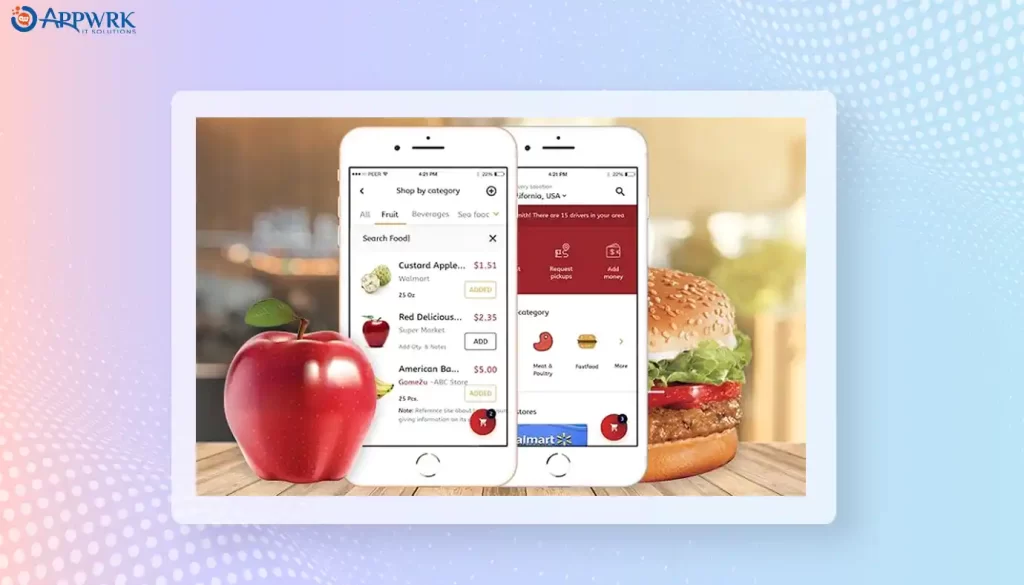
Aggregator grocery delivery apps connect shop owners with customers. In this model, business owners partner with retailers to ensure that groceries are delivered to the customers on time. These apps list the nearby grocery stores for the users, and they get the liberty to order groceries from the store they want and make payments.
If you develop an aggregator grocery delivery app, you will act as a facilitator; the sole delivery responsibility will lie on the shop owners.
Dedicated Grocery Delivery Apps
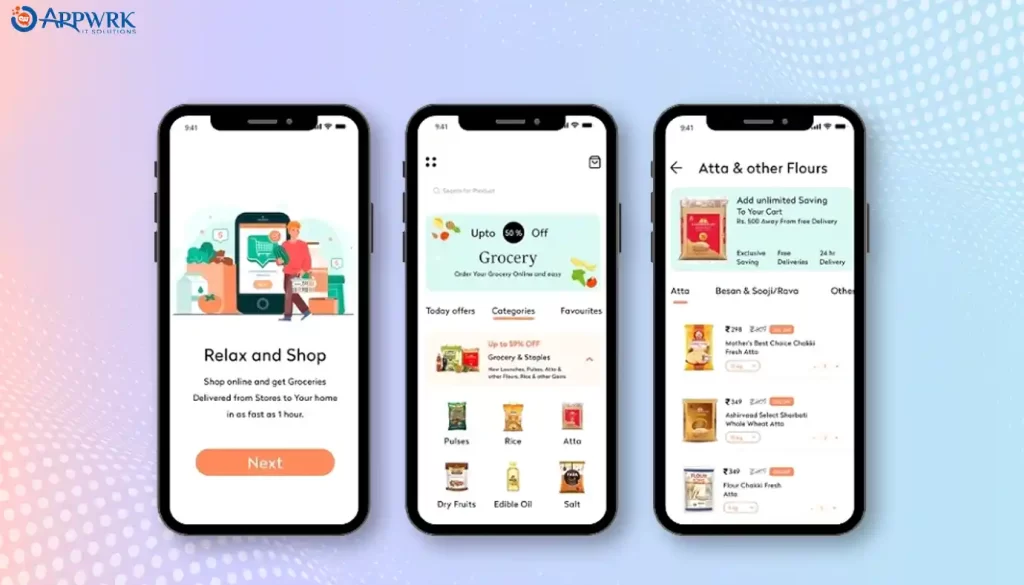
Dedicated on-demand grocery delivery apps are somewhat similar to aggregators; the only difference is that you will have to control the whole process from order placement to delivery. You will need a fleet of delivery executives to deliver the grocery items to the users’ given location.
Hyperlocal Grocery Delivery Apps
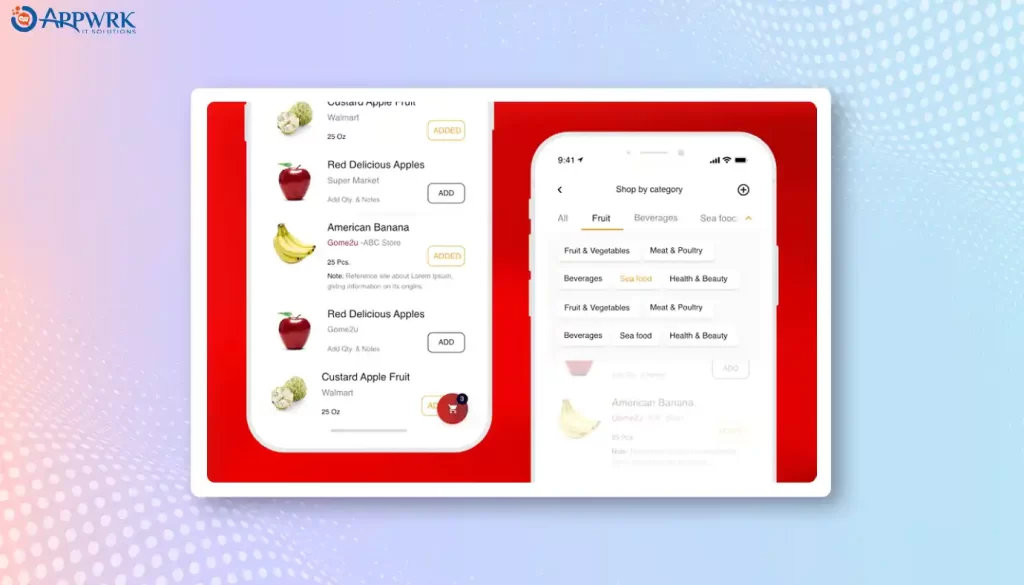
As the name implies, the hyperlocal grocery delivery app caters to a few customers’ demands within a small geographical area. Online grocery shopping has undoubtedly created a challenge for local vendors to sell their groceries. But this model has helped the traditional store by listing their items on the platform. The aggregators manage the other process from pickup to delivery, allowing local offline stores to optimize their sales. Also, the customers find it easy to order from the nearest stores with a faster delivery service.
Instacart-inspired Grocery Delivery Apps

Such delivery apps provide customers with the quickest delivery within a five to six hours time frame. It controls its distribution network, wherein the customers do not decide the store from where they want to purchase. The application prompts the vendor about a particular order, whose task is to purchase the goods from different stores and deliver them to customers on the same day. This app is beneficial for users who urgently require some groceries at their place.
Multi-Vendor Grocery Delivery Apps
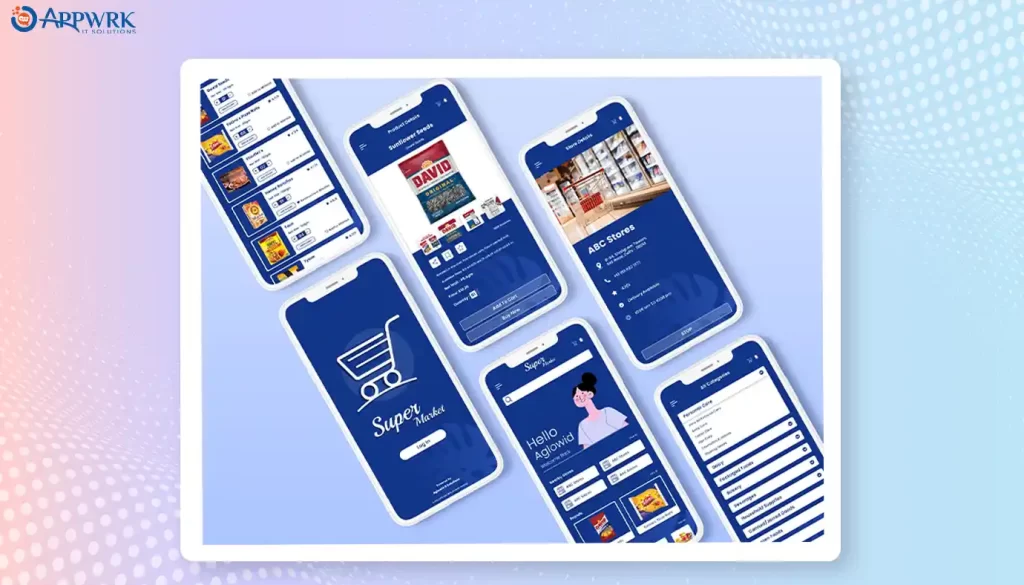
Multi-vendor grocery delivery apps provide a common platform that allows multiple sellers to carry on their business and sell products. It also helps the customers choose various products from a single platform. Internal logistics handles the shipping and delivery through the platform, which collects and delivers the required items to the customers. Examples of such an app are Amazon and eBay.
Farm-to-table Grocery Delivery Apps
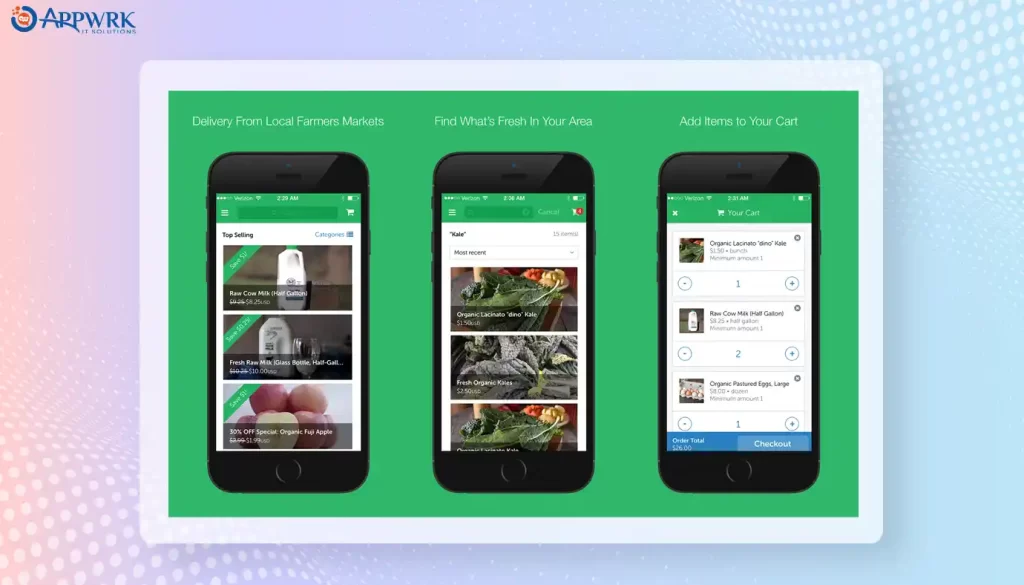
Today, consumers have become a lot more responsive towards a healthy lifestyle. Farm-to-table grocery delivery apps offer customers fresh fruits, vegetables, seafood, meat, and other fresh products. They partner with local farms all around the country to provide customers with food items that are not processed and deliver them in the minimum time possible. One such example of a farm-to-table grocery delivery app is GrubMarket which ensures to provide fresh groceries at your doorstep!
White-label Grocery Delivery Apps
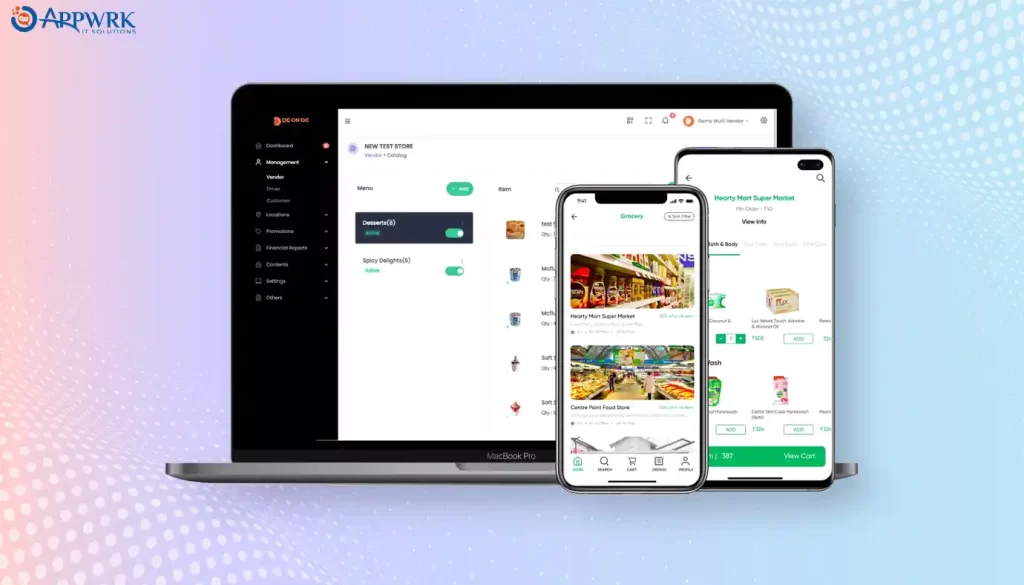
White-label grocery delivery apps are emerging due to their low investment feature. It is a pre-built app that allows you to start your business by using your own logo, color, brand name, etc., depending on your requirements. Grocery business owners are developing white-label apps as they require fewer resources and time and also help in gaining high customer reach, thereby increasing your brand value.
Top Grocery Delivery Apps Dominating the Market in 2023: Learning from the Best in the Industry
Walmart Grocery

Walmart Inc. is an American-based multinational online retailer and is a leading industry in grocery delivery service due to its easy-to-use features, fast deliveries, and secure payment methods. Users can directly order from the Walmart grocery website or download and install the app on their phones. Walmart Grocery also provides various offers and discounts with a premium membership, including free delivery on all orders for a year.
Instacart
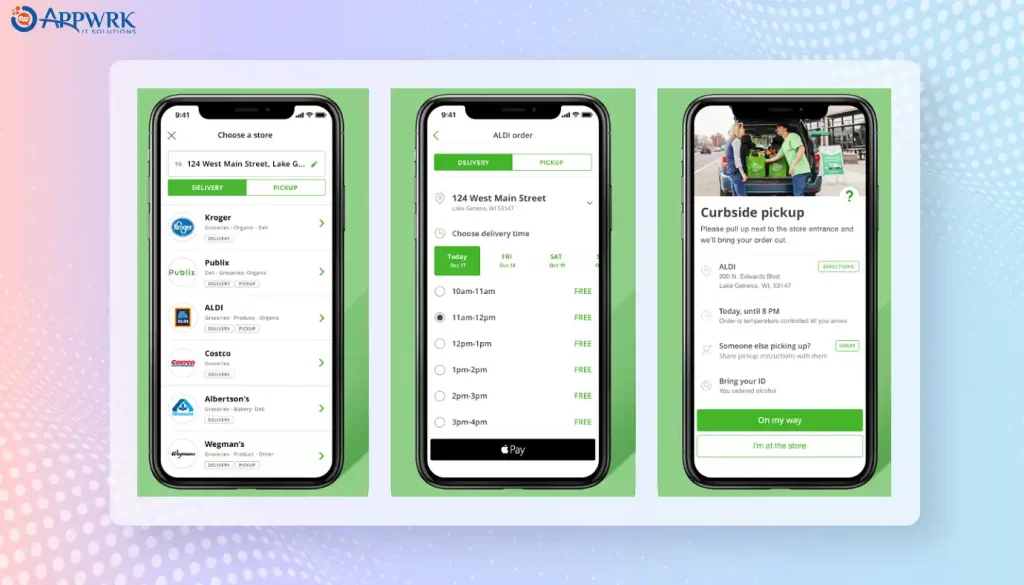
Instacart is one of the most favored local grocery stores in the U.S. This app provides same-day delivery to almost 100 cities with a minimal delivery fee. Although the delivery fee may be higher during shopping hours, it tries to offer groceries at the same price as in-store prices so that the customers do not feel a burden to pay extra. One of the essential features of Instacart is that it allows customers to pick up their groceries from the store itself rather than shipping them to the place.
Shipt
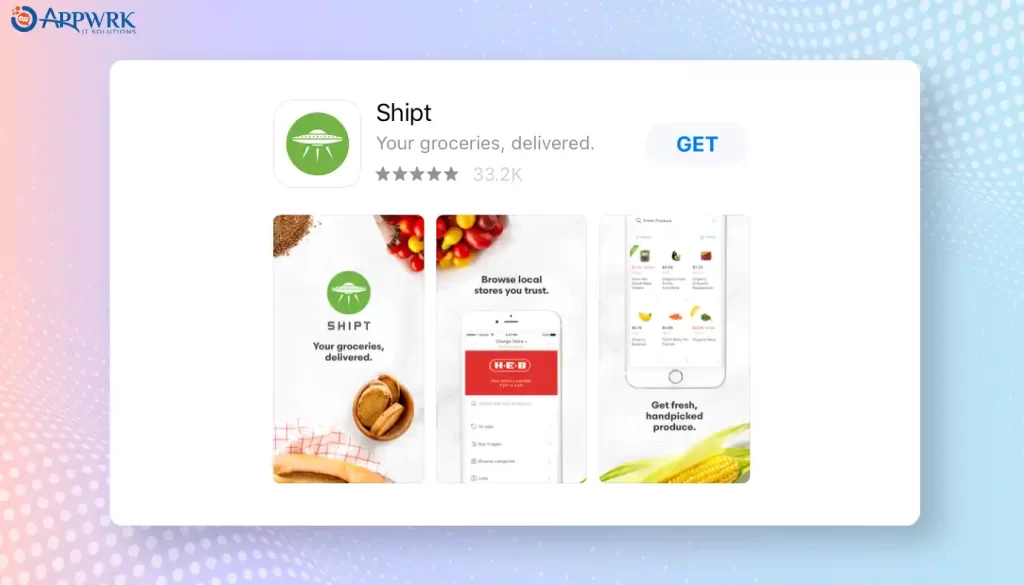
Shipt is a grocery shopping service app enabling customers to buy products from retailers based on location. This app provides 24-hour availability and delivers your groceries in a minimum one-hour time period. Shipt launched a messaging feature where the retailers can connect with shoppers regarding the unavailability of products or make any alterations to the order if needed. The users can also add delivery instructions for the shoppers during placing the order according to their requirements.
Big Basket
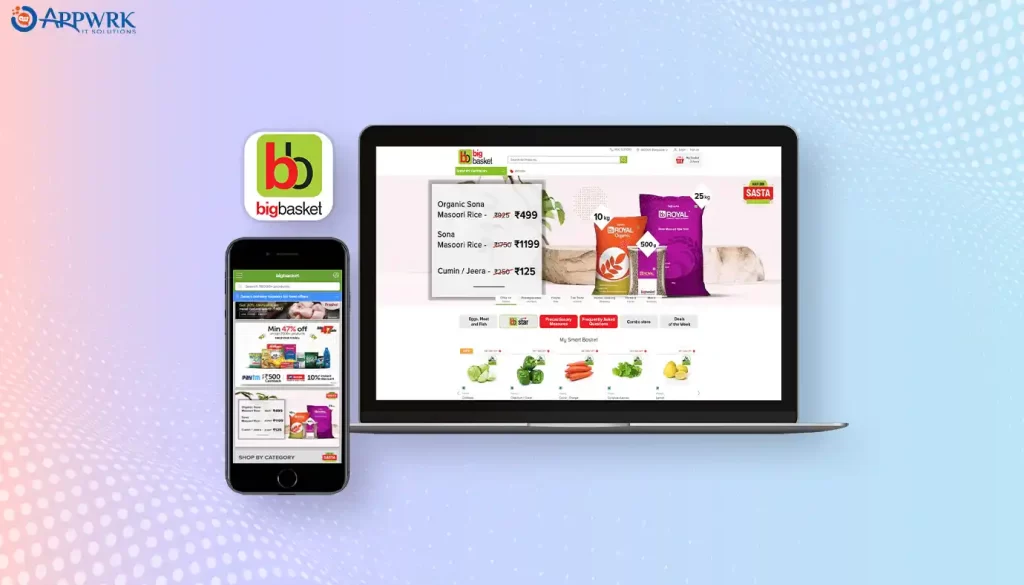
Founded in 2011, Big Basket is currently India’s largest on-demand grocery delivery app which receives nearly 150,000 orders per day. It delivers everyday cooking essentials amounting to 40,000 items, along with household products like food beverages, detergent, bakery products, ice cream, etc. Big Basket is available in seven languages and serves significant parts of India. The users can buy any product they want with multiple payment gateways available. This app also provides a customer return policy, one of the most impressive features!
Jio Mart
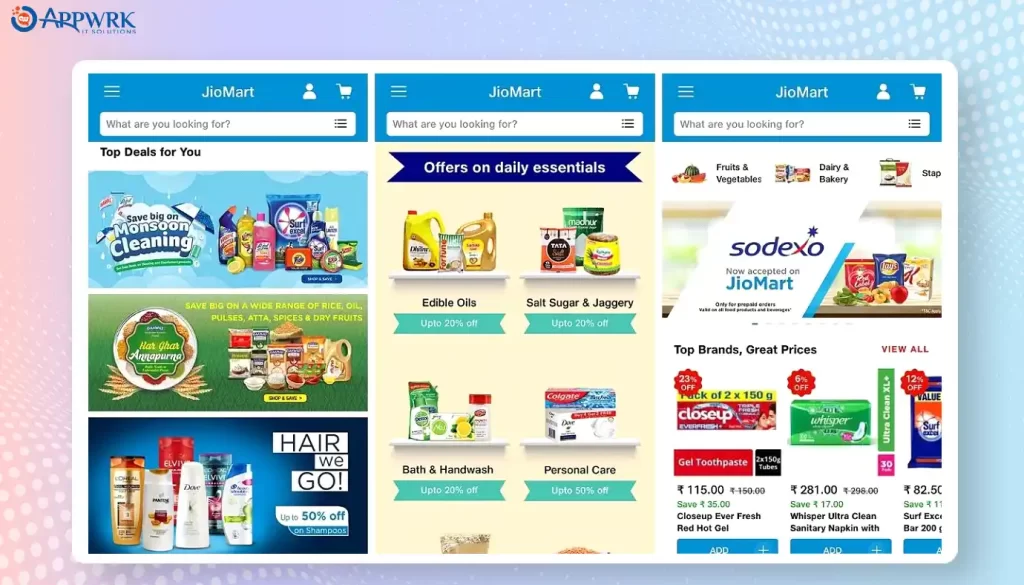
Reliance Industries Ltd, one of the biggest names in the Indian industry, launched its e-commerce platform named Jio Mart in 2020. This grocery delivery app delivers more than 50,000 food items to shoppers at low prices and fast delivery services. The Jio Mart film works with local shops rather than a warehouse infrastructure and provides personal care products, baby care products, grocery products, and many more in just one click.
Blinkit
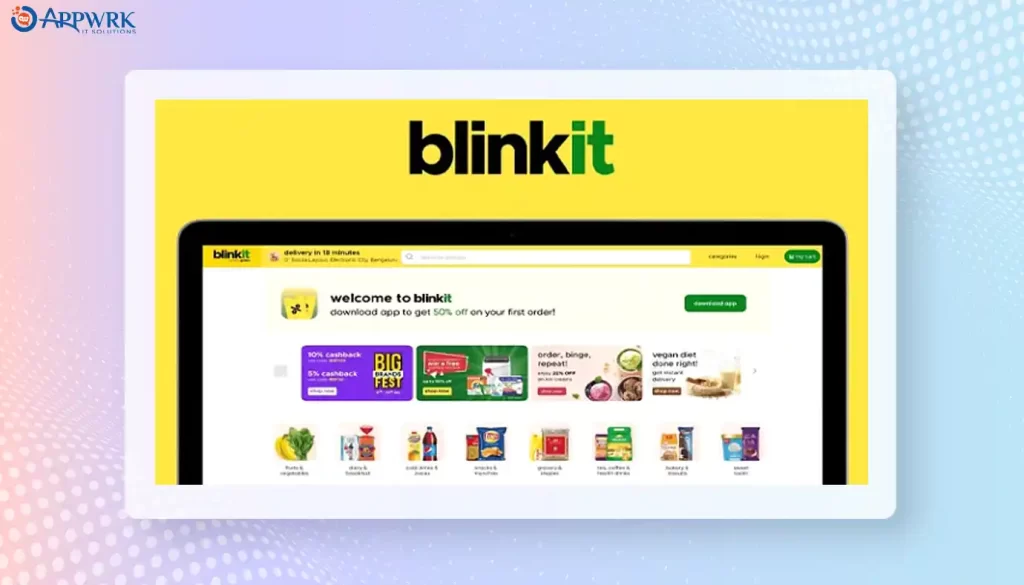
Blinkit, formerly known as Grofers, was founded in 2013 and has been the most popular choice for customers till now. This app created a buzz among users with its 10-minute delivery feature, which increased the number of customers on the platform. You can buy a variety of fruits, vegetables, and household products at the lowest price possible.
FreshDirect
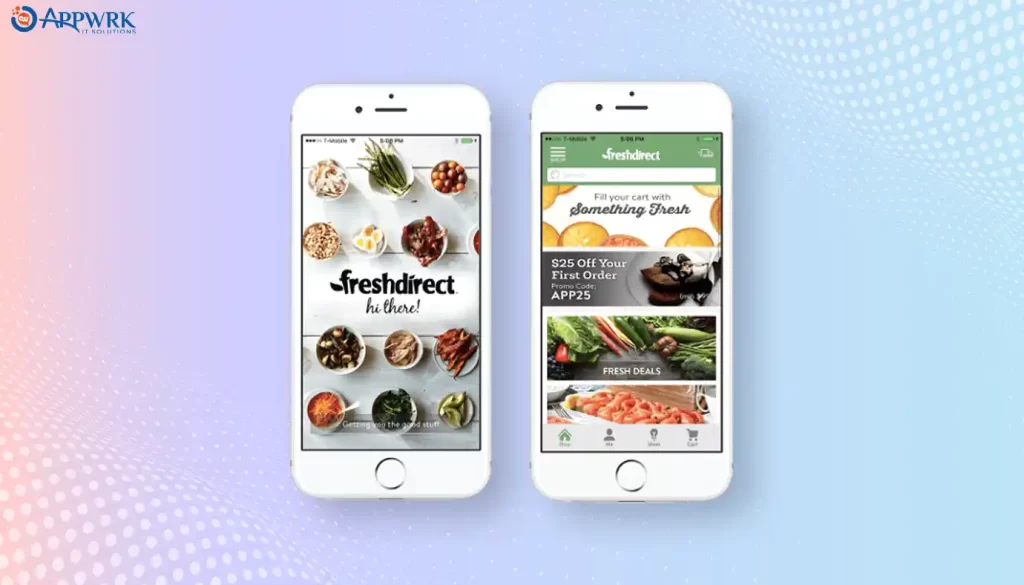
Fresh Direct is an American online grocery delivery app that has gained popularity among consumers, allowing them to schedule delivery timings up to 1 week in advance according to their convenience. It also provides one-day delivery with a minimum cart value of $30. Fresh Direct has tie-ups with local dairies, farms, and fisheries that provide a wide range of food items.
Essential Features for an Engaging Grocery App: User, Vendor, and Admin Panels
Grocery delivery app development is revolutionized with its multifaceted features. Popular multinational corporations like Amazon and Walmart have stepped into the world of globalization and are delivering across the world. There has been a drastic shift from traditional shopping to online shopping, where people are adopting new methods for comfort and convenience, but the thirst for new and innovative mobile apps will never quench.
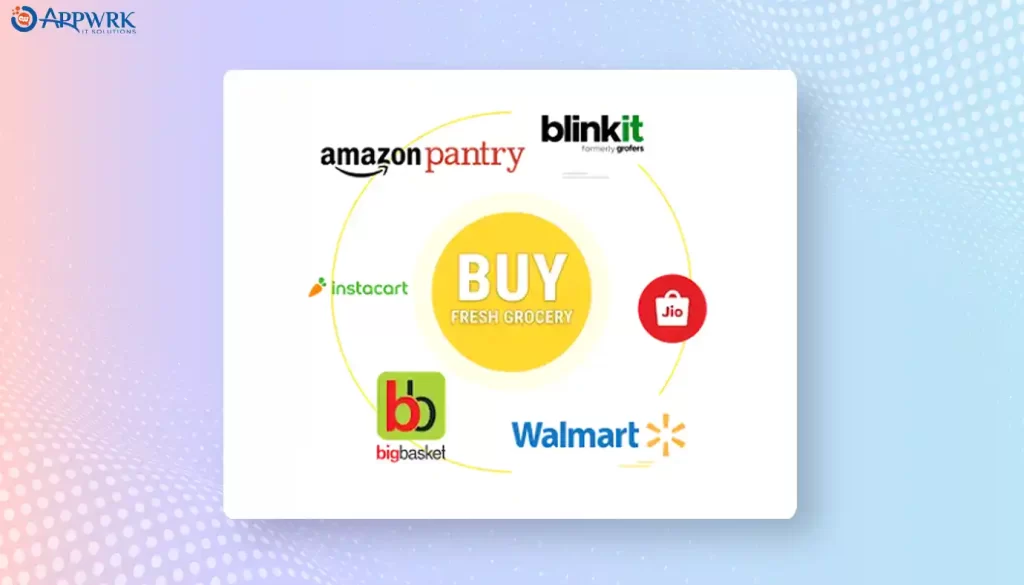
You must be aware of the fact that many grocery delivery apps are being developed, but do you want to stand out from the rest of the world? Here’s the trick! Below are mentioned the most important features that your app should include to provide a user-friendly interface to customers, vendors, as well as admins.
| Customer Panel | Store Owner Panel | Admin Panel |
| Native App | Find Stores | Dashboard |
| Easy On-Boarding | Store Location | Manage Stores |
| Browse Products | Store Pickup | Assign managers |
| Quick Search | Website Ordering | Manage listings |
| Multiple payment options | Logistics Integration | Assign orders |
| Order Tracking | Customer Support | Track orders |
| Schedule delivery | Inventory Management | Manage customers |
| Re-order | Change location options | Manage Payments |
| Push notifications | Manage offer | |
| Offer Section | Manage feedback | |
| Manage Settings | Manage notifications | |
| Feedback & Rating | Reporting and analytics | |
| Checkout |
It is crucial to look for these features to guarantee the success of your grocery delivery app development. Today, users need a simple, easy-to-use design with many features and customizations. Therefore, make sure to include these features while developing your app to enhance your journey of grocery delivery app development!
Selecting the Right Technology Stack for Your Grocery Store App Development
Developing an app for your online grocery store takes a lot into the cart! Therefore, choosing the right tech stack for grocery app development is essential. Your tech stack depends on factors like target audience, application goals, industry-specific requirements, and third-party integrations.
There are three main components of the technology stack:
Front-end technology stack
Front-end technology stack is for the clients, i.e., the customers can see and engage with the online grocery store through the app. It is responsible for the mobile app’s design and navigation, providing a rich user experience and seamless user interface. Principal elements of front-end tech stack are:
HTML, CSS, and JavaScript
Creates and makes web pages interactive and allows to implement dynamic features on web pages through its programming language.
ReactNative or Flutter
These are one of the best cross-platform development frameworks that develop apps with a single codebase on both Android and iOS, saving time and resources.
Back-end technology stack
Back-end technology stack is for the server side of software development. It refers to the app’s inner workings, which the users cannot see. Principal elements of back-end tech stack are:
Node.js, Django, or Ruby on Rails
These are popular back-end frameworks that offer scalability, performance, and ease of integration with various databases and APIs.
MongoDB, PostgreSQL, or MySQL
These databases provide a solid foundation for storing and managing your app’s data.
Third-party integrations
Integrating third-party services can enhance your app’s functionality and improve user experience. Some essential third-party integrations for grocery store app development include:
Payment gateways (Stripe, Braintree, or PayPal)
These integrations ensure secure and convenient payment processing for your customers.
Location services (Google Maps API)
This integration provides accurate location data for deliveries, store locators, and other location-based features.
Analytics and monitoring tools (Google Analytics, Firebase, or Mixpanel)
These tools help you track user behavior, monitor app performance, and make data-driven decisions to optimize your app.
The table given below shows some of the commonly used tech stacks that will help you in building your grocery delivery app:
| Mobile platforms | Android, iOS |
| Programming languages | Kotlin for Android, SwiftUI for iOS |
| Location | Google Place API, Google Maps, MapBox Navigation API, MapBox Geocoding API |
| Delivery time | Google Matrix API |
| Database | PostgreSQL, Firebase |
| Cloud environment | Azure, AWS |
| Payment gateways | Braintree, PayPal, Stripe |
| Real-time analytics | Datacode, Kafka, Prometheus, Grafana |
| Utilities | Twilio, Firebase, Google SDK, and Facebook SDK |
Everyone is using conventional front-end and back-end technology stack, but it’s your time to think out of the box and use other technologies as well. For instance, you can use AI to analyze your customer interest and preferences in developing your grocery app.
Designing a Robust Architecture for Your Grocery Delivery App
An effective architecture for a grocery delivery app should be scalable, secure, and modular to ensure smooth functioning and support future growth. Here’s a brief overview of the key components of a grocery delivery app architecture:
Frontend
This is the user interface of the app, where customers, vendors, and delivery personnel interact with the app’s features. Frontend technologies like React Native, Flutter, or Angular can be used for developing responsive and user-friendly interfaces that work seamlessly across devices and platforms.
Backend
The backend handles the app’s server-side processing, data storage, and communication with the frontend. It is responsible for managing business logic, user authentication, order processing, and other critical functions. Backend technologies like Node.js, Django, or Ruby on Rails can be used for building robust and efficient server-side infrastructure.
Database
A reliable and secure database is essential for storing user information, product details, order history, and other data. Databases like PostgreSQL, MongoDB, or MySQL can be used for organizing and managing data efficiently.
API
APIs (Application Programming Interfaces) serve as the communication bridge between the frontend and backend, enabling seamless data exchange between different components of the app. RESTful APIs or GraphQL can be used for creating a flexible and efficient API layer.
Cloud Infrastructure
Leveraging cloud services like AWS, Google Cloud Platform, or Microsoft Azure ensures scalability, reliability, and cost-effectiveness of the app. These platforms provide a range of services for hosting, storage, and managing the app’s infrastructure.
Security
Implementing strong security measures like data encryption, secure API authentication, and access control helps protect sensitive user information and ensure the app’s overall security.
Third-Party Integrations
Incorporating third-party services like payment gateways, location services, analytics tools, and push notifications enhances the app’s functionality and user experience.
By designing a well-thought-out architecture for your grocery delivery app, you can build a reliable, efficient, and feature-rich application that caters to the needs of customers, vendors, and delivery personnel alike.
Choosing the Ideal Revenue Model for Your Online Grocery Delivery App
The revenue model for your online grocery delivery app depends on various factors like customer requirements, location, available resources, and the company’s aspirations moving forward. Some of the top models you can consider while building an online grocery delivery app are listed below:
Commission-based model
The marketplace owner will receive a commission from the sellers or vendors on every sale they make on the platform.
Grocery delivery app that follows a commission-based model: Instacart
Subscription-based model
This app model allows the customers to buy a subscription or pay a membership fee, through which they can receive various offers and discounts weekly, monthly, or yearly basis from the marketplace owner.
Grocery delivery app that follows a subscription-based model: Amazon Fresh
Delivery fee model
In this model, customers are charged a minimum fee to deliver their groceries to their doorsteps within a limited time frame.
Grocery delivery app that follows a delivery fee model: Postmates
Advertising-based model
This model will allow you to earn revenue through advertisements made by grocery stores or business owners on your app to promote their products.
Grocery delivery app that follows an advertising-based model: MyGroceryDeals
Marketplace model
The customers can compare different products from various grocery stores listed on the platform and purchase according to their preferences and requirements.
Grocery delivery app that follows marketplace model: Blinkit
Inventory-based model
In this model, the customers can directly purchase from the inventory provided by the application rather than searching for various grocery stores.
Grocery delivery app that follows an inventory-based model: FreshDirect
Hybrid model
Hybrid model integrates different business models for a rich user experience and increased revenue.
Grocery delivery app that follows a hybrid model: Walmart Grocery
Coupon-based model
Customers are provided with various coupons and discounts depending on the purchase frequency and the number of transactions made on the same grocery delivery app.
Grocery delivery app that follows a coupon-based model: Ibotta
Cashback-based model
This model provides customers with cashback offers for positive engagement and encourages them to buy products repeatedly from the same application.
Grocery delivery app that follows a cashback-based model: Rakuten
Affiliate marketing model
The grocery app owner makes profits by promoting other vendors’ and sellers’ products on the platform.
Grocery delivery app that follows an affiliate marketing model: Honey
Step-by-Step Guide to Developing a Successful Grocery Delivery Application
Step 1- Comprehensive Market Research and Planning
The first step towards building your on-demand grocery delivery app is to establish a clear purpose for your development. It is necessary to do comprehensive market research and analysis to tailor your target audience. Consider the problems your app will solve, who will use it, and what value it will provide to the users. Also, evaluate your competitors’ strengths and weaknesses to stay ahead of the curve in this fast-paced world of grocery delivery apps.
Step 2- Select the Right Development Partner
Your market research can go in vain if you do not select an ideal grocery delivery app development partner. Therefore, hiring a development company that will help you select the right development approach according to your business goals and target audience is vital.
If you need a grocery delivery app development company, APPWRK will lead you forward in your journey! Our dedicated team of experts will turn your imagination into reality by building an app that will break records.
Step 3 – Determine the Optimal Platform
Choosing an optimal platform is also important as it will determine your target audience. You can select a native development approach specifically designed for a single platform, i.e., iOS or Android. Cross-platform development uses specialized tools like Flutter and React Native to build your app. You can also combine both and choose a hybrid app development approach depending on your demands and needs.
Step 4- Design and Develop a Minimal Viable Product
Minimum Viable Product is a pared-down version of your app that includes only the most essential features. MVP will focus on the core functionalities, helping validate your app idea, gather feedback, and fix issues. This will avoid over-investment in features that might not be needed and will save you time.
Step 5- Test, Refine, and Launch Your Application
Once your app is designed and developed, rigorous testing is crucial to analyze the desired quality of your app. Quality assurance will ensure no bugs or issues are found in the app for optimal performance, and it is ready to be launched on Apple Store, Play store, or both. App Store Optimization (ASO) is another crucial step that will be considered after the app launch that will help to improve your app’s visibility in app stores.
Step 6- Marketing Your Grocery App
After the release of the product, you will start marketing your grocery app through various channels like social media and influencers. Develop new referral programs to encourage users to share the app with friends and family. Also, use paid advertising channels like Google Ads and Facebook Ads to target potential customers for your on-demand grocery delivery app.
Step 7 – Continuous Analysis and Improvement
The work is not over here! The process will continue even after the app launch. You will monitor the growth and trends arising in the market. Setting up a powerful analytical framework will help keep track of your app’s overall performance. Periodic updates with new improvements and features will help to increase customer engagement and retention, thereby boosting sales in the future.
Assembling the Perfect Team to Build a Grocery Delivery Mobile App
In this competitive landscape, a perfect team is required to build a grocery delivery app for you. The development team should have detailed knowledge of the process, from market research to app maintenance. They should be aware of various customizations and be well-equipped with interactive UI/UX designs to increase customer relationships. A team should also have managerial skills with a problem-solving mindset. A perfect development should have the following members:
Project Manager
A project manager defines the scope and organizes, plans, and executes the project. He leads the entire team during the development process and ensures that all the requirements are being fulfilled by them in accordance with the instructions provided by the client.
Mobile App Developers
Mobile app developers use various programming languages and development skills to develop mobile apps. They are also responsible for testing bugs and issues before the app launch to attain an optimal level. There are primarily two types of mobile developers: Android mobile developers and iOS mobile developers, depending on the development approach.
Front-end Developers
Front-end developers create and design user experience (UX) and user interface (UI) of applications using languages like HTML, CSS, and JavaScript. They are responsible for developing the app’s user-friendly and highly interactive design.
Back-end Developers
As the name implies, back-end developers work on behind-the-scenes functionality of an app. The codes written by back-end developers help browsers to fetch data from the database.
UX/UI Designers
UX/UI designers ensure to create a positive user experience so that the users understand how to use the complex technical design and encourage them to stick to the app forever. They are responsible for an app’s overall look, including fonts, font size, colors, and graphics, to provide a complete user interface.
QA Expert
A Quality Analysis expert is responsible for monitoring and inspecting the app’s overall functionality after the app has been designed and developed. He looks for any loopholes and provides measures in order to meet the required quality standards of an app.
Reasons to Invest in Grocery Delivery Mobile App Development
On-demand grocery delivery mobile app development has become an important aspect with its plethora of benefits. It has been one of the booming sectors in the world. Thus, an investment in grocery app development will only reap fruits in the future. Some of the reasons are mentioned below.
Upscaling your business
Every owner opens a business with the aim of expanding and growing in the future. On-demand grocery app development will help increase your online presence in the market, thereby gaining a genuine customer base even for your physical stores. App development will help you grow globally, driving your sales upward.
Optimum utilization of time
With the development of the grocery delivery app, you can utilize your time in a more productive way as the work hours are flexible. You will not have to sit in a grocery store physically; instead, you will be able to handle all the orders through the app. You can also carry on other full-time jobs with your grocery business that will help you gain more revenue and profits.
Secure Payment Tracking
Grocery online apps have made it easier for businesses to manage customer transactions through multiple safe and secure payment options like UPI, net banking, wallet apps, credit cards, and debit cards. Now, you will not have to keep a record of all the transactions coming in manually. All online payments only take a few minutes to complete the transaction process, and it automatically gets transferred to your acquired bank account, which will help you keep a strong hold on your financials.
Customer Feedback
You cannot track all the behavior of the customers visiting your physical stores in a day. And so, it is impossible to get customer feedback based on their experience. However, building an on-demand grocery delivery app will keep you close to your customers. They can provide valuable feedback through the app itself, which will help improve the overall functionality and increase customer visits to your online grocery app.
Tracking customer behavior
Whenever customers visit your store, they either get a shopping list to purchase the items or directly pick up the products they think are needed while checking the price. Are you able to track their shopping behavior through physical stores? Developing an online grocery app will help monitor customers’ shopping patterns, likes, dislikes, and preferences. It will also let you know the demand for products so that you can keep extra inventory.
Gone are the days when mobile phones were used for calling and messaging. Today, mobile phones have become a hub for commercial work also. It is easy for shoppers to instantly download an app and order whenever and wherever they want. Investing in grocery delivery mobile app development will make headway toward success in the wake of digitalization.
Understanding the Cost Factors in Developing a Grocery Delivery App
Grocery delivery app development fundamentally depends on three factors:
- App complexity: Grocery delivery app development cost depends on the level of complexity you need, for instance, additional features, designs, customizations, and third-party integrations.
- Location: Grocery mobile app development cost varies from place to place. Different locations have different hourly charges for the development team.
- App platform: The cost of developing an app on an Android or iOS platform varies, which is around $10,000 -$30,000 for a single platform. App development cost also depends on the development approach you choose, whether native or cross-platform.
Therefore, a rough estimate shows that developing an on-demand grocery mobile app may cost you between $10,000 – $50,000, depending on your business goals and requirements.
Challenges of Making a Grocery Shopping App (With Their Solutions)
Design constraints
Whenever you visit a grocery store, there are huge shelves with plenty of food items on display. There are different sections for different product types, for instance, all the dairy products are kept in one corner of the store, making it easier to differentiate between food items. Is it possible to accommodate all these food items on your tiny phone screens?
Solution: You can provide multiple filter types and search preferences in your app so shoppers can easily pick up the item they want with limited items displayed on their screen. Customizations allow you to develop different sections according to product types in your app.
Can’t touch this
When you go to a store, you can see and touch the food item that is on display. You can hold the product and make choices with alternative options provided. Also, some customers believe that vegetables and fruits seen online are not fresh and natural, so they will not get quality products. Is it possible to provide customers with good-quality products?
Solution: The products can be displayed in 3D on phone screens using AR technology so that shoppers can better visualize the food item they are purchasing. Also, you can provide your customers with organic food products at reasonable prices that can keep your customer base consistent.
Where’s my order?
You order a food item online because you want to get it delivered fast and on time. Grocery delivery apps provide an estimated time when your food products will be delivered, but there are chances that your delivery time gets exceeded and delayed. Also, the routes followed by the delivery partner may be longer or shorter depending on the location, navigation, and traffic.
Solution: You can tie up with reputable mapping platforms such as Google Maps to chalk out the shortest and traffic-free routes for accurate delivery timings. Also, you can offer preset time intervals so customers can get a correct estimation of the delivery.
Personalization and Localization
Grocery delivery apps would take up another step if they provided personalized features like repeat orders, favorite items, comparison between two same products from different brands, and instant cart editing.
Solution: You can enhance personalized features by AI-powered tagging, allowing customers to analyze previous orders, and split screens to provide comparisons between the same product of different brands pertaining to cost, weight, etc.
Onboarding
You might avoid downloading an app that tells you to log in through long onboarding processes and tutorials without an option to skip.
Solution: Keep a simple onboarding process with one-tap log-ins and a ‘skip the tutorial’ feature so customers remain engaged in your app. Tech-savvy shoppers know how to use the apps today, so there is no need for long introductory tutorials.
Technical issues
Developing a grocery delivery mobile app may be challenging if the user interface (UI) and user experience (UX) are not up to the mark. Shoppers may face lags and glitches in-app after a while, which will reduce your customer retention.
Solution: For developing a glitch-free grocery app, hiring a team of experts with the best knowledge of UX/UI is essential. You should also provide timely updates and app maintenance for a better user experience.
Payment & Security Issues
The world of technology is evolving, and so are hackers. Using online apps poses a threat to users and creates payment and security issues for them. Hackers now use online apps to access and steal public data, payment information, and money.
Solution: You should implement advanced-level security in your apps without permission for third-party apps. Also, there should be regular security debugging for your app to prevent it from cyber attacks and hackers.
APPWRK IT Solutions – Grocery Delivery App Development Company
This ultimate guide has provided you with insight into how these grocery delivery apps are evolving. It has helped you know about various benefits, features, tech stack, cost, and many other aspects. But to develop a grocery app after keeping in mind all these aspects, don’t you think you need one of the best grocery delivery app development companies? Stop scrolling the article and wait! APPWRK is here to provide you with a team of talented grocery app developers who will take you on a roller coaster ride and build the most trendy grocery delivery app for you today!
APPWRK IT Solutions is a mobile app development company and a trusted partner in your long-term growth and progress journey. Our expert mobile designers and developers have completed over 2000 projects that have helped businesses scale up development, design, and digital marketing proficiency. We will provide you with the best experience in this journey of grocery app development, from market research to app maintenance.
Conclusion
Building a top-notch grocery delivery app like Instacart and Blinkit needs a thorough study of every development aspect, whether features, benefits, cost, or process. This ultimate guide has taken you through a short journey of grocery app development that has covered every point for your new project!
The trend for online shopping has reached its peak, and now there is no going back. People have found comfort in staying home and ordering anything and everything in seconds. Open the app, put your food items in the cart, and there you get it delivered in no time! Creating an on-demand grocery delivery app according to customers’ convenience will surely reap fruits in the future.
Want to develop an application for your grocery store, contact us to get the finest on-demand grocery app development services from our talented pool of mobile app developers and designers!
FAQs and Expert Answers
Some of the most inspiring trends for grocery delivery apps are:
– Quick delivery setup.
– Improving the use of customer data and privacy.
– Fresh and organic food items at the disposal.
– Retail media network expansion.
The MVP cost for developing a grocery delivery app may roughly range between $10,000 – $30,000 depending on factors like the complexity of the app, development approach type, and location.
Many development processes and different types of developers are responsible for building an app. Therefore, developing an on-demand grocery delivery app would take approximately 1900 to 2400 hours.
The grocery delivery industry leverages customer behavior data which is undoubtedly a valuable asset for online stores. They gather information about the customers regarding their likes, dislikes, and preferences. They track their consumption patterns and provide them with personalized offers and discounts. The app also uses security measures and provides a privacy policy guideline before logging in for safety purposes.
Some of the primary beneficiaries of grocery mobile app development are:
– Traditional brick-and-mortar supermarkets, hypermarkets, and grocery stores.
– E-commerce businesses that focus exclusively on selling groceries.
– Companies that specialize in delivering groceries on behalf of retailers or as an independent service.
– Businesses that offer subscription-based grocery delivery, such as meal kits or specialized food boxes.
– Small-scale farmers, producers, and artisans.
– Retailers that focus on niche markets, such as organic, vegan, or ethnic foods.
– Companies that supply groceries to retailers.
– Companies that specialize in developing and maintaining mobile apps for the grocery industry.
– Data analytics and marketing firms.
– Payment processors and FinTech companies.
Steps to build a grocery shopping app are as follows:
– Select the business model
– Decide the features that you want to include
– Finalize a team of various developers
– Select a technology stack
– Build an MVP
A rough estimate shows that developing an on-demand grocery mobile app may cost you between $10,000 – $50,000, depending on your business goals and requirements.
APPWRK IT Solutions is not just a company for app development but a trusted partner in your long-term growth and progress journey. Our expert mobile designers and developers have completed over 2000 projects that have helped businesses scale up development, design, and digital marketing proficiency. We will provide you with the best experience in this journey of grocery app development, from market research to app maintenance.
About The Author
